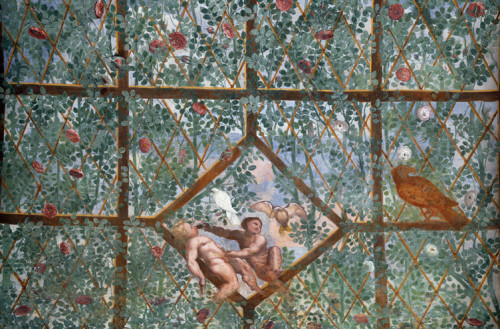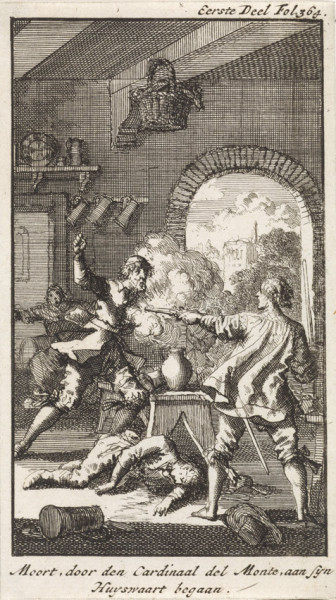Cardinal Innocenzo Ciocchi del Monte (1532–1577) – the pope’s favorite with criminal inclinations

Decorations in the form of a pergola with putti, villa Giulia - residence of Pope Julius III, pic. Wikipedia

Cardinal Innocenzo del Monte shoots in a tavern and kills two people, drawing - Jan Luyken, 1667, pic.Wikipedia
In the history of the Church, there was a good number of dignitaries full of pride and sin, but the history of this cardinal is head and shoulders above the rest. It is so improbable that it begs telling. It clearly shows the existence of a network of connections, obligations, and interests, which made the papal nepots into figures that were both above the law and at the same time respected. And even if one of them experienced temporary problems, it was enough to wait out until the next Conclave and get into the good graces of the newly elected bishop of Rome. As it would seem, this model is alive and well until this very day.
In the history of the Church, there was a good number of dignitaries full of pride and sin, but the history of this cardinal is head and shoulders above the rest. It is so improbable that it begs telling. It clearly shows the existence of a network of connections, obligations, and interests, which made the papal nepots into figures that were both above the law and at the same time respected. And even if one of them experienced temporary problems, it was enough to wait out until the next Conclave and get into the good graces of the newly elected bishop of Rome. As it would seem, this model is alive and well until this very day.
His father Angelino Santino served in the court of the del Monte family, while his mother remains unknown. At the age of approximately thirteen, he showed up in Parma in the service of the cardinal and papal legate Giovanni Ciocchi del Monte. According to legend, a boy named Fabiano won his trust by defending the cardinal against a tamed monkey. The cardinal accepted the boy at his court and gave him the task of caring for the monkey – an animal that at that time was often kept as a pet in aristocratic households. However, that is not all. When del Monte set off for Trent (1545) in order to represent the pope on the largest council in the history of the Church, he took his favorite with him. As the American historian Francis Burkle-Young claims, the over-fifty-year-old cardinal was probably attracted by the youth’s grace, energy, and sense of humor to such an extent that he convinced his brother Baldovino to adopt him, and thus bestow him with the family name, as well as a new first name – Innocenzo (meaning innocent). Of course, this fact gave rise to numerous rumors, with assumptions being made that he is either the cardinal’s lover or a child born out of wedlock. The then commentators, as long as they were Protestants (meaning they disliked the pope), were inclined to believe the former version, while Catholics were more favorably disposed towards the latter. But even they muttered something about the cardinal’s love for boys, which is testified to by notes left on the subject by the valued (Catholic) chronicler Onofrio Panvinio.
The cardinal's brother was tasked with preparing the boy for his new life. His education did not proceed too well, but apparently, his manners improved sufficiently enough for the fourteen-year-old (!) to take over the post of the provost of the cathedral chapter at Arezzo.
As soon as cardinal del Monte ascended to the throne of St. Peter as Julius III, the boy was granted numerous titles and appanages and became a cardinal, which paved the way for him becoming one of the pope's trusted nepots. This fact angered members of the Curia. Not only due to the fact that it elevated a boy who was poorly educated or due to nepotism (widely accepted), and not even because of the Holy Father’s weakness towards the youth. The principal barrier was his heritage – the fact of being a child born out of wedlock, which at that time closed all doors to becoming a cardinal. Cardinals, including the future pope Carafa (Paul IV), emphasized the fact that, in face of an ongoing crisis of the Church connected with the battle against Protestantism, the talks of the Council of Trent – moving towards the introduction of reforms, it would be unreasonable and embarrassing to elevate Innocenzo to the rank of cardinal ("the prostitution of the dignity of the Sacred College”). But even this failed to convince the pope. For what else could have justified the actions of the head of the Church, other than deep feelings? Burkle-Young claims that it could have been an infatuation with Fabiano's freshness, liveliness, and sense of humor, which in times of the crisis of the Church, could have appeared to Julius III – as desirable characteristics of "a new man for new times". Unfortunately, this new, energetic, and young cardinal did not exhibit any worthy of mentioning positive features. Innocenzo who was ridiculed as “the monkey cardinal”, displayed an utter lack of preparation to hold any kind of office. And he did hold quite a few – cardinal deacon of San Onofrio, legate in Bologna, commendatory abbot of the abbeys in Mont Saint-Michel in Normandy, San Zeno, and Verona, as well as San Saba, Miramont, Grottaferatta, and Frascati, finally protector of the Roman House of Catechumens. Another reason for the Holy Father's weakness towards Innocenzo was perhaps the pragmatic desire to increase the number of trusted advisors who would create the foundation of the future power of the del Monte family of which the pontifex dreamed. Seeing the weaknesses of his favorite he even decided to create a new office – secretary of state of the State of the Church, which today is one of the most important in the Church, but in the past was nothing more than a sinecure for the adolescent nepot. And although after the death of his benefactor in 1555 Innocenzo’s significance decreased greatly, he still was a cardinal, who participated in two Conclaves occurring in rapid succession, during which popes Marcellus II and then Paul IV were elected. The latter was furious upon hearing that Innocenzo got into a fight during a banquet (1559) over the famous in Rome courtesan Martuccia, but did nothing to subdue the quick-tempered, violent, and sexually-active cardinal. After the death of Paul IV (on his way to another Conclave), “the monkey cardinal” killed two men (an innkeeper and his son), but he avoided punishment, since it occurred during the so-called vacancy (meaning a time when there was no head of the State of the Church), while the subsequent pope, Pius IV declared a universal amnesty for that time period. But even after that fact, the cardinal did not change his lifestyle. He was often seen at parties thrown by courtesans, took part in nightly sabre duels, often wore plain clothes, and carried a weapon. He was finally imprisoned in the Castle of the Holy Angel, after killing his servant. However, a few months later he was set free at the intercession of Duke Cosimo I de’ Medici and thanks to rather large sums of money which the nobleman paid. The cardinal was given over to the Jesuits, who were to watch him and work on his morale. At that time he still held the honors of titular cardinal of two Roman churches (San Callisto and Santa Maria in Campitelli), and after the election of the next pope, Pius V (to which he contributed), he took over the function of protodeacon of the Sacred College. During the Conclave, he was caught breaking the sacred principle of the secrecy of this gathering, and immediately after (certain of the pope's support), he was involved in yet another scandal. He kidnapped two women (of low social status) whom he imprisoned and subsequently raped. And once again it was Cosimo I who aided the cardinal. The pope quartered the cardinal in the Vatican and gave him over to the care of two Theatines. Innocenzo was once again publically disgraced, a few months later when he was caught in the company of two prostitutes. And perhaps even then nothing would have happened, had it not been for the fact that this occurred during the Holy Week, which the young man was celebrating in this rather unusual way. Let us recall, that the strict Pope Pius V was fervently opposed to immorality and prostitution in the city and spoke out against it in his inauguration speech. The Vatican was to be an example, while Rome from a city of prostitution was to become a city of virtue. In order to achieve this prostitutes were to marry. This idea, however, was heavily opposed to by the city senate, which claimed that in the Eternal City, whose male population predominantly lives in celibacy, it would be dangerous to remove harlots, as it would disturb the peace of virtuous women, and most of all would favor sodomy (homosexualism) and although the pope initially had street girls persecuted and whipped these arguments did not fall on deaf ears. Ultimately he allowed prostitution but only in specifically marked quarters of the city.

This time Innocenzo had good reason to worry. The pope imprisoned him in the Castle of the Holy Angel and established a commission of cardinals which was to look into the accusations he was charged with. However, it cleared him of all the charges, claiming that while the cardinal did indeed use the services of prostitutes and broke the rules of celibacy, as was evidenced by the rapes he had previously committed, the commission found no reason to strip him of his titles, especially since he willingly admitted to everything he had been accused of. The cardinals stated that his life is so wanton that there appears to be no possibility of improvement, which resulted in him being locked away in the Monte Cassino monastery along with several servants and Jesuits who watched over him. Then he was moved to a monastery in Bergamo, where he spent the next few years awaiting the next Conclave, in which this time (at the order of Pius V), he could not participate. At that time his stepbrother was killed, and thus Innocenzo became the sole male heir of Baldovino del Monte. At that moment the former supporter of the cardinal, Grand Duke Cosimo I, finally collected on his debt of gratitude – annexing the lands belonging to the del Monte family and incorporating them into the Great Duchy of Tuscany.
The imprisoned but still young Innocenzo decided to take his fate into his own hands. Counting on the immediate departure of the strict Pius V, he made diplomatic attempts that would allow him to return to Rome. There he could count upon his fellow cardinals, who still remembered the good, carefree times of Julius III, and perhaps still evoked tender memories of the feasts and trips to the pope's suburban villa (Villa Giulia). Nevertheless, he found himself at the side of the next pope, Gregory XIII, whom he crowned as the successor of St. Peter, being the protodeacon. And although this enfant terrible with a very colorful lifestyle, taken out from a period long gone, aroused both interest and ridicule, in 1574 he became a member of two cardinal congregations.

